RIYADH: Dubai’s residential market activity hit record highs in the second quarter with 35,310 transactions, a 20.5 percent year-on-year increase, driven by customizable units and stable investment returns, a new report showed.
According to a study conducted by the UAE’s real estate company Primo Capital, this surge was driven by a 23.9 percent rise in off-plan property sales and a 15.2 percent increase in secondary market deals.
This comes as real estate activities generate around 5.5 percent of the UAE’s overall gross domestic product, according to the latest data by global platform Statista.
Primo Capital further stated that this trend reflects enduring confidence among prospective buyers and strong demand within the industry.
Furthermore, the shift by leading developers in the UAE from one rigid design to a customer-centric construction has boosted activity, according to Mohammad Zeaiter, senior property advisor at Primo Capital.
He explained that giving the buyers the freedom to choose, change and customize according to their tastes and preferences is a major reason for the growth.
“Moreover, the fertile grounds of real estate market guarantee steady ROI (return on investment) and higher capital gain are captivating the international investor’s interest more than any other major metropolitan cities including New York, London, Singapore and Hong Kong,” he added.
The average home price in Dubai rose by 20.7 percent year-over-year, with flats and villas seeing increases of 20.4 percent and 22.1 percent, respectively, confirming Dubai’s status as a premier global real estate investment destination, the report stated.
In Abu Dhabi, the residential sector also showed positive growth, with villa prices increasing by 2.3 percent and apartment prices by 4.3 percent year-over-year, indicating continuous expansion.
The commercial real estate market in Dubai displayed impressive performance, with average rents rising by 22.2 percent annually and 17.1 percent quarterly, driven by the expanding needs of companies and businesses within the thriving UAE economy.
Additionally, the industrial and logistics sector saw annual rental rate increases of up to 14.3 percent, attributed to heightened demand for warehouses and storage facilities.
The hospitality sector maintained a strong performance, with a 0.9 percentage point annual increase in average occupancy rates, showcasing the industry’s resilience and adaptability despite high visitor rates.
Retail rental rates also saw significant increases, with Abu Dhabi and Dubai experiencing average rental rises of 14.7 percent and 10.5 percent, respectively, over the year preceding the first quarter of 2024, reflecting a supply-demand mismatch and heightened commercial activity.
Real estate agents at Primo Capital foresee sustained growth in the UAE’s real estate market, driven by factors such as a robust economy, significant return on investment, higher capital returns, and favorable government policies.






















